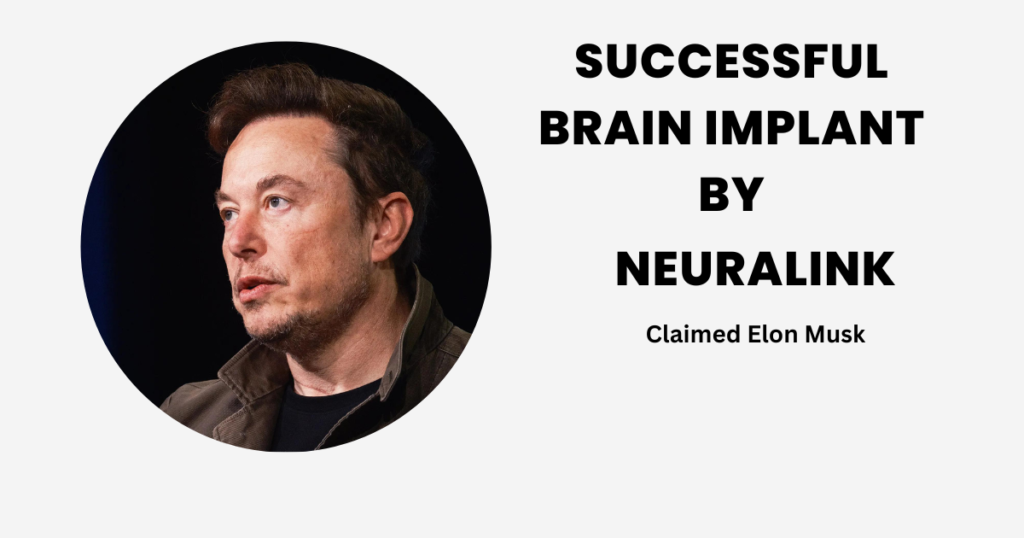
San Francisco, January 29, 2024: In a groundbreaking announcement on X, formerly Twitter, Elon Musk, the tech magnate and founder of Neuralink, revealed that the first human patient has successfully received a brain implant developed by his company. The Neuralink startup has successfully implanted a brain chip in a human patient for the first time. This marks a significant milestone in the field of brain-computer interfaces (BCIs) and holds immense potential for revolutionizing healthcare and human capabilities.
Musk Tweeted the News:
- “The first human received an implant from Neuralink yesterday and is recovering well,” Musk declared on X, formerly known as Twitter.
- “Initial results show promising neuron spike detection,” he added, hinting at the implant’s ability to pick up on the brain’s electrical activity
Neuralink’s Ambitious Project: Blurring the Lines Between Brain and Machine
Neuralink, founded in 2016 by Elon Musk with a team of world-renowned neurotechnologists, harbors a vision as audacious as it is groundbreaking: to forge a direct connection between the human brain and the boundless potential of computer technology. This isn’t simply about creating gadgets and apps; it’s about fundamentally reshaping our understanding of what it means to be human in the digital age.
The project’s ambitions are multifaceted. At its core, Neuralink seeks to establish a neural lace, a network of ultra-thin, flexible threads implanted into the brain that can seamlessly translate its complex electrical signals into digital communication. This opens a realm of possibilities, including:
- Augmenting human capabilities: Imagine controlling external devices directly through thought, boosting learning and memory, or even enhancing your senses to perceive the world in entirely new ways. Neuralink envisions a future where our minds become extensions of the digital world, allowing us to interact with information and technology in ways previously unimaginable.
- Combatting neurological disorders: For millions battling debilitating conditions like paralysis, Parkinson’s, and ALS, Neuralink offers a flicker of hope. By bypassing damaged neural pathways or restoring lost functionalities, these brain-computer interfaces could potentially alleviate symptoms and empower individuals to regain control over their lives.
- Unlocking the potential of AI: Ultimately, Neuralink’s vision extends beyond individual enhancement. The company aspires to foster a symbiotic relationship between humans and artificial intelligence. By establishing a two-way flow of information between our minds and machines, we could unlock unprecedented levels of collaboration and problem-solving, propelling humanity to new heights of innovation and understanding.
Read Also: Brain Transplant 101: Everything You Need to Know
Details of the Link: A Bridge Between Brain and Machine
The revolutionary “Link” implant, the cornerstone of Neuralink’s human trials, is more than just a piece of hardware. It’s a meticulously crafted bridge between the intricacies of the human brain and the boundless potential of computer technology.
Size and Scope:
- Roughly the size of five stacked coins, the Link is surprisingly compact considering the complexity of its tasks. It sits comfortably within the skull, housed in a biocompatible enclosure designed to withstand the harsh conditions of the human body.
- Unlike some competitors, the Link requires invasive surgery for placement. While this may raise concerns, Neuralink has developed a sophisticated robotic system that speeds up the process and minimizes risks.
Technology Within:
- The Link is far more than just a passive implant. It boasts a miniaturized marvel of engineering, packed with advanced features, including:
- Thousands of hair-thin electrodes: These delicate threads seamlessly integrate with the brain tissue, capturing the subtle electrical symphony of neurons firing.
- Custom-designed chips: Powerful yet energy-efficient, these chips process the neural signals in real-time, deciphering their meaning and transmitting them wirelessly for external interpretation.
- Wireless charging: Gone are the days of invasive battery replacements. The Link charges wirelessly from outside the body, ensuring long-term functionality and comfort.
FDA Approval and Beyond:
- The Link’s journey to the human brain wasn’t a simple one. Years of rigorous testing and meticulous refinement culminated in Neuralink receiving FDA approval for human trials, marking a crucial milestone in the field of brain-computer interfaces.
- This first successful implant is just the beginning. As Neuralink continues its trials and gathers data, the Link has the potential to evolve, becoming even more refined and capable of facilitating even more complex interactions between brain and machine.
The Link, therefore, is not just a device; it’s a symbol of human ingenuity and ambition. It represents a bold step towards a future where technology seamlessly augments our lives, opening doors to unimaginable possibilities in healthcare, cognition, and our understanding of the human mind itself.
Future Implications:
- While Musk’s announcement is undeniably exciting, it’s important to remember that this is still early days.
- Further research and rigorous testing are necessary to fully assess the safety, efficacy, and long-term implications of these technologies.
- Ethical considerations surrounding BCIs remain a crucial discussion point, requiring careful navigation as this field evolves.
Despite these uncertainties, Elon Musk’s announcement undoubtedly marks a significant milestone in the field of neurotechnology. As Neuralink continues its human trials and progresses in its research, the world will be watching with keen interest to see how this technology shapes the future of human-computer interaction and, potentially, the lives of countless individuals.

Leave a Reply
You must be logged in to post a comment.